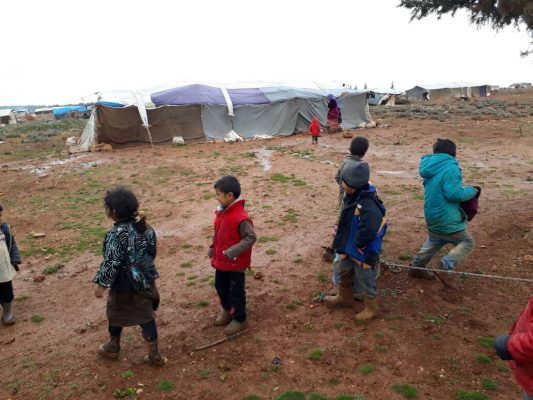What if Idlib falls?

"Choosing to stand tall and fight seems to be the choice made by the majority of youth in the southern Rif"
A few kilometers away from the frontline battle in South Eastern Rif Idlib, entire areas are lost as Baath party forces and their allies advance. Villages and towns fall after tens of airstrikes. This rather rapid progress gets you thinking. What’s next? What if this area is lost?
Idlib province is considered the last bastion of the Syrian revolution which started on March 15, 2011. The majority of armed militias are gathered in this province which is the only province entirely escaping the control of Assad forces, with the exception of two small villages north of the center of the province. However, these two villages are besieged by the revolution armed factions and were included in the “Four Cities Agreement”. According to records, 1.5 million people live in Idlib; however, the number of inhabitants in the province is estimated today at over two millions, as a result of the policy adopted by the Baath regime and its allies to move populations in other provinces to Idlib. The city of Idlib was part of the de-escalation agreement signed by Turkey with Russia and Iran. This gave the people of Idlib the opportunity to catch their breath and go back to leading normal lives for a short while. But the agreement did not last for long. When the regime forces completed their mission to control Deir ez-Zor province alongside Kurdish forces, the focus was shifted back to Idlib.
People here are saying that once the operations are done in Deir ez-Zor, the focus will shift to them, but they also say it was a chance to go back to leading normal lives.
The population was not able to get ready yet for the assault. It had already started in south eastern Rif Idlib. Many regions had quickly fallen in the hands of regime forces and the opposition armed factions could not repel them despite that they are numerous. Some locals say that disagreement between these factions played an important role in the success achieved by regime forces.
Unprecedented bombardment and shelling facilitated the progress. So people had no choice but to flee their towns and villages. Without prior notice, people quickly gathered their things as the Assad forces were advancing so fast they could only think of saving their lives. The days to come won’t be easy. They will be long and exhausting days for everyone, especially women and children.
No accurate census is available about the numbers of displaced people. Many vehicles loaded with belongings were seen on the roads connecting Idlib villages to one another. Women and children sat on those belongings as if the vehicles were mobile homes. However, activists estimate the number of displaced at tens of thousands.
People of Idlib rely on their strong ally, Turkey, to defend the de-escalation agreement. They believe Turkey is capable of shifting things back in their favor, while others think that Turkey is acting based on its own interests and that it is ready to sacrifice the whole city for political leverage with Russia at its southern borders.
While civilians rely on Turkey, some Islamic factions stand alone as they refused the Astana and de-escalation agreements. However, they were not able to resist for long, so other opposition factions had to engage in battle against Assad forces in eastern Rif Idlib due to the danger posed by their progress.
Eastern Rif Idlib is constituted of sparsely populated small villages. The progress achieved by Assad forces forced their inhabitants to flee to northern and southern Idlib who think that if Assad forces are able to control the eastern side of the province, their next target would be their cities and villages in the southern part.
The eastern and southern parts of the province are very different from each other demographically. The former is constituted of sparsely populated small villages, while the latter is constituted of densely populated large cities including Khan Sheikhun, Maarat al-Numan, Kfarnabel and many others.
The fact that the southern part is densely populated could mean a disaster if regime forces attempt to advance towards that part, as arbitrary bombardment precedes any advance and massive waves of people will move north. However, the north can no longer accommodate more displaced people. The peoples’ choices are more limited than ever before. Fleeing north is not the solution. Fleeing itself is a difficult choice to begin with.
Rajab al-Shaheen, a construction worker, believes that if Assad forces advance towards their region, he would be left with no option but the option he vowed to take which is to defend his land. He would send his family with those who decided to flee north.
Choosing to stand tall and fight seems to be the choice made by the majority of youth in the southern Rif; however, the majority of the population believes that fleeing is the best option for the safety and survival of their children and women.
The Syrian-Turkish borders are already full of people displaced from north Idlib and won’t be the destination of most people deciding to flee. Some might think of fleeing to Turkey. But Turkey fears the influx of more refugees into its territory which is why it had built a wall at its borders and had clearly stated it would not welcome new refugees.
Sneaking into Turkish territory is a dangerous business. Turkish border guards do not hesitate to shoot civilians escaping bombardments and death. Local activists had documented several incidents of people getting killed at the Syrian- Turkish borders. Any option chosen by civilians is an option imposed by war. It would certainly not be a stroll in the park especially if Idlib falls.
